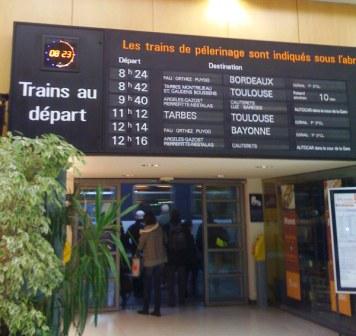![tgv[2] tgv[2]](https://enchantedtraveler.wordpress.com/wp-content/uploads/2009/10/tgv2.jpg?w=625) France enjoys one of the most modern, extensive, high-speed rail networks in the world. The renowned Train à Grande Vitesse (TGV) network will whisk you across the country in a just a few hours. And the Eurostar is heaven….central Paris to central London in a mere 2 hours 15 minutes. Here are some of my top tips for enjoying the trains in France.
France enjoys one of the most modern, extensive, high-speed rail networks in the world. The renowned Train à Grande Vitesse (TGV) network will whisk you across the country in a just a few hours. And the Eurostar is heaven….central Paris to central London in a mere 2 hours 15 minutes. Here are some of my top tips for enjoying the trains in France.![130-42_4DImageDoc[1] 130-42_4DImageDoc[1]](https://enchantedtraveler.wordpress.com/wp-content/uploads/2009/10/130-42_4dimagedoc1.jpg?w=625)
Gare du Nord – Paris’ busiest train station, with Eurostar to London; also Belgium, Netherlands, Northern Germany
Gare de l’Est – Eastern France, Austria, Germany, German-speaking part of Switzerland
Gare du Lyon – Central and south-east France, French Riviera, French speaking part of Switzerland, Italy and connecting service into Spain through Montpellier
Gare Montparnasse – Western and south-western France (southern Normandy, Brittany, Pays de la Loire, Tours by TGV, Poitou-Charentes, Aquitaine, Midi-Pyrénées) and north-western Spain.
Gare d’Austerlitz – South Central France, Toulouse and Pyrenees; night trains to south of France and Spain
Gare du Bercy – near Gare du Lyon, provides service for overnight trains to Italy: Florence, Milan, Rome, Venice
Charles de Gaulle – Gare Aeroport CDG – most convenient if you are flying in and making an immediate connection – you may not have to transfer to central Paris at all. Travel directly from the airport via high speed TGV to Avignon, Brussels, Lille, Lyon and Nice.
Gare St. Lazare – serves Normandy, including Caen, Vernon, Le Havre, Cherbourg, Deauville, Lisieux
Detailed practical information on each station can be found here at Rail Europe’s Paris station pages.
2. Travel like a local – Second class travel is just fine, and you’ll meet more Europeans that way. Who wants to be upfront with the business travelers?
3. Tickets – Don’t count on purchasing your ticket at the train station kiosks. Most accept only European credit cards that have a chip which U.S. issued cards don’t have. Purchase your France rail pass before you leave home, or purchase point to point tickets at the train station office. Check with a travel agent or Rail Europe for details on the many great options. France rail passes are offered for 3-9 days of travel. If you plan to travel only 1 or 2 days, you’ll want point-to-point tickets. Also, if you have a short-haul trip in mind, it may be more cost effective to purchase a point-to-point ticket for that leg, and save your Rail Pass day for a longer, more expensive journey. Click here for the SNCF website in English, which has point to point schedules and prices.
4. Reservations – Eurail and France pass travelers, be aware that the high speed TGV trains and night trains ALWAYS require advance reservations, payment of a nominal fee, and space may be capacity controlled. Reserve your train early to ensure your place, especially at peak travel times. When I arrive in one station, I usually visit the ticket window before I leave to make reservations for the next leg of the journey. You can also make reservations in advance from your travel agent from whom you purchased your pass, or directly on Rail Europe’s reservation page.
5. Dining – Most French trains of any distance have an informal dining car, with drinks and snacks, and some even offer kids meals in a cute plastic zip container. Convenience can be pricey though. Take a tip from the locals and pick up a fresh baguette, some local cheeses, fresh fruit and beverage of choice before you head to the station, and enjoy your picnic onboard. Many train stations also have surprisingly good patisseries – yum! – and sell sandwiches to go (emporter).


6. Travel light – Chances are you’ll be lifting all the bags onto and off of the train by yourself. Most trains have overhead shelves to store smaller items. Storage areas for larger bags are at the ends of the cars, where you may not be able to keep an eye on your belongings. If you’re concerned about theft, bring along a bicycle-type lock to secure bags to the storage shelves.
![113-02_4DImageDoc[2] 113-02_4DImageDoc[2]](https://enchantedtraveler.wordpress.com/wp-content/uploads/2009/10/113-02_4dimagedoc2.jpg?w=625)
7. Be alert – Like any major gathering place in the world, train stations have their share of pickpockets. Carry cash, credit cards and passports in a money belt, and keep a watchful eye on your bags.
8. Right Place at the Right Time – Note the platform your train will be leaving from and arrive early. You may need to traverse up and down several flights of stairs to reach your platform, so again, travel light..bring only what you can comfortably carry yourself. Most platforms have an electronic (or manual) board noting the composition of the trains, i.e. first class and second class cars. Position yourself accordingly on the platform while you wait for the incoming train. Each car will be marked with a 1 or a 2, indicating whether it’s first or second class. Stations stops can be brief, and they don’t wait for you, so be ready to board. Likewise, be alert as to when it’s time to get off. Know the names of the stations that are several stops prior to your stop, so you can begin to collect your belongings and position yourself towards the exit doors.

9. Onboard bathrooms – Okay, maybe not the most glamorous, but serviceable. Most cannot be used while the train is in the station (I won’t go into detail here), and the water is usually non-potable. Traveling with your own hand sanitizer and small pack of tissues is always a good idea.
10. Eurostar – I saved the best for last. You really can’t beat the convenience and modern amenities. Easy to see why high speed Eurostar service under the Chunnel beats air travel – no checked bag fees, no long security wait lines, no 2 hour advance check in. It’s a breeze traveling from Paris’ Gare du Nord station to London’s bright new St. Pancras station. St. Pancras is almost a destination within itself with shops, restaurants, bars, and Europe’s longest champagne bar. For the best insider tips on traveling Eurostar, check out frequent Eurostar traveler’s Paris Perfect blog post for excellent suggestions, including which cars are most convenient.
Eurostar’s a terrific way to get from Paris to London, but I learned the hard way this summer that you must allow plenty of time to get through customs and airport-type security before boarding. There were long lines, unlike with regular trains. Next time I’ll arrive at least an hour early.
It is fantastic isn’t it? Two and a half hours from Paris to London!
These are great tips! Your photos make me want to hop on a plane.
Wonderful article. Makes me miss the excellent train networks in Europe since ours here in Australia do NOT compare.
Nice post and greta info! Makes me want to buy a ticket now.
Excellent blog!!! i loved every photo and every tip you shared.
Cheers!
Sneo
Thanks so much for your kind words!! Greatly appreciated!